A Livelihood Resilience Measurement Framework for Dam-Induced Displacement and Resettlement
Abstract
1. Introduction
2. The Livelihood Resilience Measurement (LRM) Framework
2.1. Theoretical Framework
2.2. Model Framework
2.3. Indicator Selection
2.3.1. State Vector
2.3.2. Influencing Factors
3. Material and Methods
3.1. Study Area
3.2. Data Source
3.3. Calculation Procedures
4. Results
4.1. Descriptive Statistics
4.2. The Livelihood Resilience scores
4.3. Correlation Analysis
- (1)
- Correlation with the livelihood capital index
- (2)
- Correlation with subjective self-evaluated resilience
4.4. Multiple Linear Regression Analysis
5. Discussion
5.1. Implications of Livelihood Strategies for Livelihood Resilience
5.1.1. Which Capital Stocks Are Playing a role in Absorbing Risks?
5.1.2. Who Determines the Connectivity of the System and the Transformation of Livelihoods?
5.1.3. What Is the Key Factor for Buffering?
5.2. Advantages of the LRM Framework
6. Conclusions
Author Contributions
Funding
Acknowledgments
Conflicts of Interest
References
- Hussein, H.; Menga, F.; Greco, F. Monitoring transboundary water cooperation in sdg 6.5.2: How a critical hydropolitics approach can spot inequitable outcomes. Sustainability 2018, 10, 3640. [Google Scholar] [CrossRef]
- Hussein, H.; Conker, A.; Grandi, M. Small is beautiful but not trendy: Understanding the allure of big hydraulic works in the Euphrates-Tigris and Nile waterscapes. Mediterr. Politics 2020, 18, 1–24. [Google Scholar] [CrossRef]
- Menga, F.; Swyngedouw, E. Water. Technol. Nation State 2018, 2, 14–23. [Google Scholar]
- Menga, F. Building a nation through a dam: The case of Rogun in Tajikistan. Natl. Pap. 2015, 43, 479–494. [Google Scholar] [CrossRef]
- Conker, A.; Hussein, H. Hydraulic Mission at Home, Hydraulic Mission abroad? Examining Turkey’s Regional ‘Pax-Aquarum’ and Its Limits. Sustainability 2019, 11, 228. [Google Scholar] [CrossRef]
- Conker, A. An Enhanced notion of power for inter-state and transnational hydropolitics: An Analysis of Turkish-Syrian Water Relations and the Ilısu Dam Conflict between the Opponents and Proponents of the Dam. Am. J. Phys. Med. Rehabil. 2014, 94, 153–162. [Google Scholar]
- Annys, S.; Adgo, E.; Ghebreyohannes, T.; Van Passel, S.; Dessein, J.; Nyssen, J. Impacts of the hydropower-controlled Tana-Beles interbasin water transfer on downstream rural livelihoods (northwest Ethiopia). J. Hydrol. 2018, 569, 436–448. [Google Scholar] [CrossRef]
- Building Natural Disaster Response Capacity—Sound Workforce Strategies for Recovery and Reconstruction. Available online: http://ir.canterbury.ac.nz/bitstream/handle/10092/10481/12651073_apec-natural-disasters-workforce-project.pdf?sequence=1&isAllowed=y (accessed on 13 December 2018).
- Zhao, X.; Tian, Y.; Duan, Y.F. Research on the interventional poverty problem of reservoir migrants from the perspective of dual social change. Agricultural Economic Issues 2018, 20, 108–118. (In Chinese) [Google Scholar]
- Hasbullah, M.; Solle, M.S. Dam, project affected families, resettlement. Soc. Plast. Eng. 2013, 40, 1–10. [Google Scholar] [CrossRef]
- Gong, Y.; Yao, K.; Zhang, R.; Liu, B.; Wang, F. Rethinking livelihood resilience after development-induced displacement and resettlement: A case study of qianping reservoir. Int. J. Water Resour. Dev. 2020, 8, 1–24. [Google Scholar] [CrossRef]
- Li, B.; & Cao, S. Research on the problems and countermeasures of farmland transfer and livelihood restoration of reservoir immigrants—Based on the survey of 21 Danjiangkou reservoir resettlement villages in Hubei Province. Hubei Agric. Sci. 2017, 56, 3174–3178. (In Chinese) [Google Scholar]
- Zhang, C. Research on the restoration of living standards of reservoir rural migrants. Yangtze River 2017, 48, 97–100. (In Chinese) [Google Scholar]
- Folke, C.; Carpenter, S.; Elmqvist, T.; Gunderson, L.; Holling, C.S.; Walker, B. Resilience and sustainable development: Building adaptive capacity in a world of transformations. Ambio A J. Hum. Environ. 2002, 31, 437–440. [Google Scholar] [CrossRef] [PubMed]
- Carpenter, S.R.; Walker, B.L.E.; Anderies, J.M.; Abel, N. From metaphor to measurement: Resilience of what to what? Ecosystems 2001, 4, 765–781. [Google Scholar] [CrossRef]
- Bruneau, M.; Chang, S.E.; Eguchi, R.T.; Lee, G.C.; O’Rourke, T.D.; Reinhorn, A.M.; Shinozuka, M.; Tierney, K.; Wallace, W.A.; von Winterfeldt, D. A framework to quantitatively assess and enhance the seismic resilience of communities. Earthq. Spectra 2003, 19, 733–752. [Google Scholar] [CrossRef]
- Mavhura, E. Applying a systems-thinking approach to community resilience analysis using rural livelihoods: The case of Muzarabani district, Zimbabwe. Int. J. Disaster Risk Reduct. 2017, 25, 248–258. [Google Scholar] [CrossRef]
- Cooper, S.J.; Wheeler, T. Adaptive governance: Livelihood innovation for climate resilience in Uganda. Geoforum 2015, 65, 96–107. [Google Scholar] [CrossRef]
- Li, C.; Wang, L.; Kang, B.; Gao, M. Measurement of livelihood resilience of relocated farmers and analysis of influencing factors. J. Xi’an Jiaotong Univ. (Soc. Sci.) 2019, 39, 38–47. (In Chinese) [Google Scholar]
- Liu, J.; Wang, Y.; Dai, L. A Study on the influencing factors of the support participation degree of rural migrants in the Three Gorges Reservoir area based on the hierarchical regression model—Taking Fuling District of Chongqing as an example. Hubei Agric. Sci. 2019, 58, 188–192. (In Chinese) [Google Scholar]
- Li, W.; Shuai, C.; Shuai, Y.; Cheng, X.; Liu, Y.; Huang, F. How Livelihood Assets Contribute to Sustainable Development of Smallholder Farmers. J. Int. Dev. 2020, 32, 408–429. [Google Scholar] [CrossRef]
- Xu, D.; Ma, Z.; Deng, X.; Liu, Y.; Huang, K.; Zhou, W.; Yong, Z. Relationships between Land Management Scale and Livelihood Strategy Selection of Rural Households in China from the Perspective of Family Life Cycle. Land 2020, 9, 11. [Google Scholar] [CrossRef]
- Marchese, D.; Reynolds, E.; Bates, M.E.; Morgan, H.; Clark, S.S.; Linkov, I. Resilience and sustainability: Similarities and differences in environmental management applications. Sci. Total Environ. 2017, 613–614, 1275–1283. [Google Scholar] [CrossRef] [PubMed]
- Resilient Livelihoods-Disaster Risk Reduction for Food and Nutrition Security Framework Programme. Available online: http://www.fao.org/3/a-i3270e.pdf (accessed on 10 May 2019).
- Disaster Risk Reduction: Strengthening Livelihood Resilience. Available online: http://www.fao.org/docrep/018/i3325e/i3325e15.pdf (accessed on 28 January 2019).
- Thulstrup, A.W. Livelihood resilience and adaptive capacity: Tracing changes in household access to capital in Central Vietnam. World Dev. 2015, 74, 352–362. [Google Scholar] [CrossRef]
- Peng, S.P.; Shi, G.Q.; Zhang, R.L. Social stability risk assessment: Status, trends and prospects—A case of land acquisition and resettlement in the hydropower sector. Impact Assess. Proj. Apprais. Accepted, in press. [CrossRef]
- Manyena, S.B.; Machingura, F.; O’Keefe, P. Disaster resilience integrated framework for transformation (drift): A new approach to theorizing and operationalizing resilience. World Dev. 2019, 123, 104587. [Google Scholar] [CrossRef]
- Gordon, J. Structures; Penguin: London, UK, 1978; pp. 54–76. [Google Scholar]
- Pimm, S.L. The complexity and stability of ecosystems. Nature 1984, 307, 321–326. [Google Scholar] [CrossRef]
- Holling, C.S. Resilience and stability of ecological systems. Annu. Rev. Ecol. Syst. 1973, 4, 1–23. [Google Scholar] [CrossRef]
- Wildavsky, A. Searching for Safety; Transaction: Moncton, NB, Canada, 1989; pp. 74–91. [Google Scholar]
- Twigg, J. Good practice review disaster risk reduction. Disasters 2004, 44, 31–60. [Google Scholar]
- Nuttall, M. Anticipation, climate change, and movement in Greenland. Études/Inuit/Stud. 2010, 34, 21–37. [Google Scholar] [CrossRef]
- Managing the Risks of Extreme Events and Disasters to Advance Climate Change Adaptation (SREX). Available online: http://www.ipcc-wg2.gov/SREX/ (accessed on 9 March 2013).
- Whitney, C.K.; Bennett, N.J.; Ban, N.C.; Allison, E.H.; Armitage, D.; Blythe, J.L.; Yumagulova, L. Adaptive capacity: From assessment to action in coastal social-ecological systems. Ecol. Soc. 2017, 22, art22. [Google Scholar] [CrossRef]
- Jerneck, A.; Olsson, L. Adaptation and the poor: Development, resilience and transition. Clim. Policy 2008, 8, 170–182. [Google Scholar] [CrossRef]
- Jones, L.; Samman, E.; Vinck, P. Subjective measures of household resilience to climate variability and change: Insights from a nationally representative survey of Tanzania. Ecol. Soc. 2018, 23, 9. [Google Scholar] [CrossRef]
- Nyamwanza, A.M. Livelihood resilience and adaptive capacity: A critical conceptual review: Original research. Jàmbá J. Disaster Risk Stud. 2012, 4, 1–6. [Google Scholar] [CrossRef]
- Sina, D.; Chang-Richards, A.Y.; Wilkinson, S.; Potangaroa, R. A conceptual framework for measuring livelihood resilience: Relocation experience from Aceh, Indonesia. World Dev. 2019, 117, 253–265. [Google Scholar] [CrossRef]
- Miller, F.; Osbahr, H.; Boyd, E.; Thomalla, F.; Bharawani, S.; Ziervogel, G.; Hinkel, J. Resilience and vulnerability: Complementary or conflicting concepts? Ecol. Soc. 2010, 15, 1–25. [Google Scholar] [CrossRef]
- Holling, C.S. Understanding the Complexity of Economic, Ecological, and Social Systems. Ecosystems 2001, 4, 390–405. [Google Scholar] [CrossRef]
- Walker, B.H.; Holling, C.S.; Carpenter, S.S.R.; Kinzig, A. Resilience, adaptability and transformability in social–ecological systems. Ecol. Soc. 2014, 9. Available online: ftp://131.252.97.79/Transfer/WetlandsES/Articles/walker_04_socio-ecology_resilience.pdf (accessed on 16 March 2018). [CrossRef]
- Pelling, M. Adaptation to Climate Change: From Resilience to Transformation; Routledge: London, UK, 2011. [Google Scholar]
- Ingrisch, J.; Bahn, M. Towards a Comparable Quantification of Resilience. Trends Ecol. Evol. 2018, 33, 251–259. [Google Scholar] [CrossRef]
- Fang, Y.; Zhu, F.; Qiu, X.; Zhao, S. Effects of natural disasters on livelihood resilience of rural residents in Sichuan. Habitat Int. 2018, 76, 19–28. [Google Scholar] [CrossRef]
- Ifejika Speranza, C.; Wiesmann, U.; Rist, S. An indicator framework for assessing livelihood resilience in the context of social–ecological dynamics. Glob. Environ. Chang. 2014, 28, 109–119. [Google Scholar] [CrossRef]
- Adger, W.N. Social and ecological resilience: Are they related? Prog. Hum. Geogr. 2000, 24, 347–364. [Google Scholar] [CrossRef]
- Cutter, S.L. The landscape of disaster resilience indicators in the USA. Nat. Hazards 2016, 80, 741–758. [Google Scholar] [CrossRef]
- Manyena, S.B.; O’Brien, G.; O’Keefe, P.; Rose, J. Disaster resilience: A bounce back or bounce forward ability? Local Environ. 2011, 16, 417–424. [Google Scholar]
- Woods, D.D. Four concepts for resilience and the implications for the future of resilience engineering. Reliab. Eng. Syst. Saf. 2015, 141, 5–9. [Google Scholar] [CrossRef]
- Chen, J.; Yin, S.; Gebhardt, H.; Yang, X. Fanners’ livelihood adaptation to environmental change in an arid region: A case study of the minqin oasis, northwestern china. Ecol. Indic. 2018, 93, 411–423. [Google Scholar] [CrossRef]
- Walker, B.H.; Carpenter, S.; Anderies, J.; Abel, N.; Cumming, G.; Janssen, M.; Lebel, L.; Norberg, J.; Peterson, G.D.; Pritchard, R. Resilience Management in Social–Ecological Systems: A Working Hypothesis for a Participatory Approach. Conserv. Ecol. 2002, 6, 14. Available online: http://www.consecol.org/vol6/iss1/art14 (accessed on 12 May 2018). [CrossRef]
- Folke, C. Resilience: The emergence of a perspective for social–ecological systems analyses. Glob. Environ. Chang. 2006, 16, 253–267. [Google Scholar] [CrossRef]
- Barrett, C.B.; Constas, M.A. Toward a theory of resilience for international development applications. Proc. Natl. Acad. Ences USA 2014, 111, 14625–14630. [Google Scholar] [CrossRef]
- Yarveisy, R.; Gao, C.; Khan, F. A simple yet robust resilience assessment metrics. Reliab. Eng. Syst. Saf. 2020, 197, 106810. [Google Scholar] [CrossRef]
- Duan, Y.F.; Zhao, C.F. Reservoir resettlement urbanization resettlement model: Basic elements, institutional barriers and institutional arrangements. J. China Three Gorges Univ. (Humanit. Soc. Sci. Ed.) 2016, 38, 14–18. (In Chinese) [Google Scholar]
- Liu, H. Advanced Material Mechanics; Higher education press: Beijing, China, 1985; pp. 23–78. [Google Scholar]
- Zhu, X.; Su, C. Research on supply chain elasticity based on Hooke’s law. Logist. Technol. 2010, 11, 102–105. (In Chinese) [Google Scholar]
- Walker, B.H.; Ludwig, D.; Holling, C.S.; Peterman, R.M. Stability of semiarid savanna grazing systems. J. Ecol. 1981, 69, 473–498. [Google Scholar] [CrossRef]
- Stringham, T.K.; Krueger, W.C.; Shaver, P.L. State and transition modeling: An ecological process approach. J. Range Manag. 2003, 56, 106–113. [Google Scholar] [CrossRef]
- Yang, Q.; Meng, J.; Wang, X. Spatial evaluation and promotion strategy of ecotourism carrying capacity in the upper reaches of the Lijiang River based on multidimensional state space method. Acta Sci. Nat. Univ. Pekin. 2015, 51, 131–140. [Google Scholar] [CrossRef]
- Qi, Y. MATLAB realization of modern control theory. Electr. Autom. 2012, 34, 5–7. (In Chinese) [Google Scholar]
- Wu, S.; Shi, G. Institutional logic, practical dilemma and solutions to the benefits of reservoir resettlement sharing hydropower projects. J. Hohai Univ. (Philos. Soc. Sci.) 2018, 20, 45–51. (In Chinese) [Google Scholar]
- Peng, F.; Zhou, Y.; Li, Y. Study on Influencing Factors of livelihood risk of reservoir migrants. Stat. Decis. 2016, 6, 60–62. [Google Scholar] [CrossRef]
- Cemea, M.M. Involuntary Resettlement in Development Projects: Policy Guidelines in World Bank-Financed Projects; World Bank Publications: Washington, DC, USA, 1988. [Google Scholar]
- Collins, C. The Neighborhood as a Social Structure for Collective Action: The Role of Bonding Social Capital, Civic Engagement and Neighborhood Racial Homogeneity; Michigan State University: East Lansing, MI, USA, 2013. [Google Scholar]
- Karimi, S.; Taifur, W.D. Resettlement and development: A survey of two of Indonesia’s Koto Panjang resettlement villages. Int. J. Water Resour. Dev. 2013, 29, 35–49. [Google Scholar] [CrossRef]
- How’s Life? Measuring Well-Being, OECD Publishing. Available online: http://dx.doi.org/10.1787/9789264121164-en (accessed on 3 November 2019).
- Du, Y.S.; Li, F. Resettlement strategy for rural reservoir resettlement in the context of urbanization. Rural Econ. 2014, 06, 109–112. (In Chinese) [Google Scholar]
- Fan, Q.X.; Lu, Y.M.; Qiang, M.S.; Wang, H.H. Research on the resettlement methods of China’s hydropower development reservoirs from the perspective of sustainable development. J. Hydroelectr. Eng. 2015, 34, 237–244. (In Chinese) [Google Scholar]
- Lindsey, J.; d’Errico, M. Whose resilience matters? Like-for-like comparison of objective and subjective evaluations of resilience. World Dev. 2019, 124, 104632. [Google Scholar] [CrossRef]
- Zhou, J.X.; Yu, K.P. Structural Dynamics, 2nd ed.; Harbin Institute of Technology Press: Harbin, China, 2009; pp. 12–34. [Google Scholar]
- Berkes, F.; Colding, J.; Folke, C. Navigating Social-Ecological Systems: Building Resilience for Complexity and Change; Cambridge University Press: Cambridge, UK, 2003; Volume 9. [Google Scholar]
- Ifejika Speranza, C.; Kiteme, B.; Wiesmann, U. Droughts and famines: The underlying factors and the causal links among agro-pastoral households in semi-arid Makueni district, Kenya. Glob. Environ. Chang. 2008, 18, 220–233. [Google Scholar] [CrossRef]
- Adger, W.N. Vulnerability. Glob. Environ. Chang. 2006, 16, 268–281. [Google Scholar] [CrossRef]
- Defining Disaster Resilience: A DFID Approach Paper. London, UK, pp.1–20. Available online: https://www.gov.uk/government/publications/defining-disaster-resilience-a-dfid-approach-paper (accessed on 5 December 2018).
- Erenstein, O.; Hellin, J.; Chandna, P. Poverty mapping based on livelihood assets: Ameso-level application in the Indo-Gangetic Plains, India. Appl. Geogr. 2010, 30, 112–125. [Google Scholar] [CrossRef]
- Shi, G.; Wu, R.; Zhou, X. Implicit imbalance of rights and interests and its solution: The plight and outlet of reservoir migrant women. Soc. Sci. Yunnan 2018, 1, 149–156. (In Chinese) [Google Scholar]
- Yang, H.; Zhu, Z.; Wu, J. Practice of “soil based” agricultural resettlement in Xiaowan Hydropower Station. Yunnan Hydropower 2019, 35, 7–11. (In Chinese) [Google Scholar]
- Quandt, A. Measuring livelihood resilience: The Household Livelihood Resilience Approach (HLRA). World Dev. 2018, 107, 253–263. [Google Scholar] [CrossRef]
- Janssen, M.A.; Bodin, O.; Anderies, J.M.; Elmqvist, T.; Ernstson, H.; McAllister, R.R.J.; Olsson, P.; Ryan, P. A network perspective on the resilience of social– ecological systems. Ecol. Soc. 2006, 11, 1–15. [Google Scholar] [CrossRef]
- Li, X.; Kunnathur, A.S.; Ragu-Nathan, T.S.; Jitpaiboon, T. Development and Validation of Learning Capability Construct in IOS Supply Chain Network Context. In Proceedings of the Paper Presented at the Decision Sciences Institute 2008 Annual Meeting, Baltimore, Maryland, 20 October 2012; Available online: http://www.decisionsciences.org/Proceedings/DSI2008/docs/253-9820.pdf (accessed on 20 October 2012).
- Boillat, S.; Berkes, F. Perception and interpretation of climate change among Quechua farmers of Bolivia: Indigenous knowledge as a resource for adaptive capacity. Ecol. Soc. 2013, 18, 21. [Google Scholar] [CrossRef]
- Rist, S.; Chiddambaranathan, M.; Escobar, C.; Wiesmann, U. “It was Hard to Come to Mutual Understanding”—The Multidimensionality of Social Learning Processes Concerned with Sustainable Natural Resource Use in India, Africa and Latin America. Syst. Pract. Action Res. 2006, 19, 219–237. [Google Scholar] [CrossRef]
- Birkmann, J. Measuring vulnerability to promote disaster-resilient societies: Conceptual frameworks and definitions. Towards Disaster Resilient Soc. 2006, 1, 9–54. [Google Scholar]
- Paton, D. Disaster preparedness: A social-cognitive perspective. Disaster Prev. Manag. Int. J. 2003, 12, 210–216. [Google Scholar] [CrossRef]
- Twigg, J. Characteristics of a Disaster-Resilient Community: A Guidance Note; University College London, Benefield Hazard Centre: London, UK, 2009; Available online: http://discovery.ucl.ac.uk/1346086/1/1346086.pdf (accessed on 17 April 2020).
- Aldrich, D.P. Building Resilience: Social Capital in Post-Disaster Recovery; University of Chicago Press: Chicago IL, USA, 2012. [Google Scholar]
- Statistical Bulletin of National Economic and Social Development of Xinyang City in 2017. Xinyang, China. Available online: http://www.xytjj.gov.cn/www/tjzl/tjgb/2018/0330/25658.html (accessed on 23 April 2019).
- Wang, S. Feasibility study on measuring residents’ living standard with Engel coefficient. Stat. Res. 2002, 19, 19–22. [Google Scholar] [CrossRef]
- Lindsey, J.; Thomas, T. ‘subjective resilience’: Using perceptions to quantify household resilience to climate extremes and disasters. Reg. Environ. Chang. 2016, 17, 229–243. [Google Scholar] [CrossRef]
- Uy, N.; Takeuchi, Y.; Shaw, R. Local adaptation for livelihood resilience in Albay, Philippines. Environ. Hazards 2011, 10, 139–153. [Google Scholar] [CrossRef]
- Merritt, W.S.; Patch, B.; Reddy, V.R.; Syme, G.J. Modelling livelihoods and household resilience to droughts using Bayesian networks. Environ. Dev. Sustain. 2016, 18, 315–346. [Google Scholar] [CrossRef]
- Erenstein, O.; Hellin, J.; Chandna, P. Livelihoods, poverty and targeting in the Indo-Gangetic Plains: A spatial mapping approach. New Delhi, CIMMYT and the Rice-Wheat Consortium for the Indo-Gangetic Plains (RWC). 2007. Available online: http://citeseerx.ist.psu.edu/viewdoc/download?doi=10.1.1.924.6384&rep=rep1&type=pdf (accessed on 17 October 2019).
- Zhou, Y.; Li, X.; Liu, Y. Rural land system reforms in china: History, issues, measures and prospects. Land Use Policy 2019, 91, 104330. [Google Scholar] [CrossRef]
- Mellino, S.; Buonocore, E.; Ulgiati, S. The worth of land use: A Gis–emergy evaluation of natural and human-made capital. Sci. Total Environ. 2015, 506–507, 137–148. [Google Scholar] [CrossRef]
- Guan, R.; Wang, W.L.; Yu, J. The impact of endogenous motivation on household income under the framework of sustainable livelihood. J. Northwest Af. Univ. (Soc. Sci. Ed.) 2019, 19, 130–139. (In Chinese) [Google Scholar]
- Wang, P.; Yan, J.; Hua, X.; Yang, L. Determinants of livelihood choice and implications for targeted poverty reduction policies: A case study in the YNL river region, Tibetan Plateau. Ecol. Indic. 2019, 101, 1055–1063. [Google Scholar] [CrossRef]
- Liu, W.; Li, J.; Xu, J. Effects of disaster-related resettlement on the livelihood resilience of rural households in China. Int. J. Disaster Risk Reduct. 2020, 49, 101649. [Google Scholar] [CrossRef]
- Petzold, J.; Ratter, B.M.W. Climate change adaptation under a social capital approach—An analytical framework for small islands. Ocean Coast. Manag. 2015, 112, 36–43. [Google Scholar] [CrossRef]
- Adger, W.N. Social capital, collective action, and adaptation to climate change. Econ. Geogr. 2009, 79, 387–404. [Google Scholar] [CrossRef]
- Li, E.; Deng, Q.; Zhou, Y. Livelihood resilience and the generative mechanism of rural households out of poverty: An empirical analysis from Lankao County, Henan Province, China. J. Rural Stud. 2019. [Google Scholar] [CrossRef]
- Olsson, L.; Jerneck, A.; Thoren, H.; Persson, J.; O’Byrne, D. Why resilience is unappealing to social science: Theoretical and empirical investigations of the scientific use of resilience. Sci. Adv. 2015, 1, e1400217. [Google Scholar] [CrossRef]
- Toole, S.; Klocker, N.; Head, L. Re-thinking climate change adaptation and capacities at the household scale. Clim. Chang. 2016, 135, 203–209. [Google Scholar] [CrossRef]
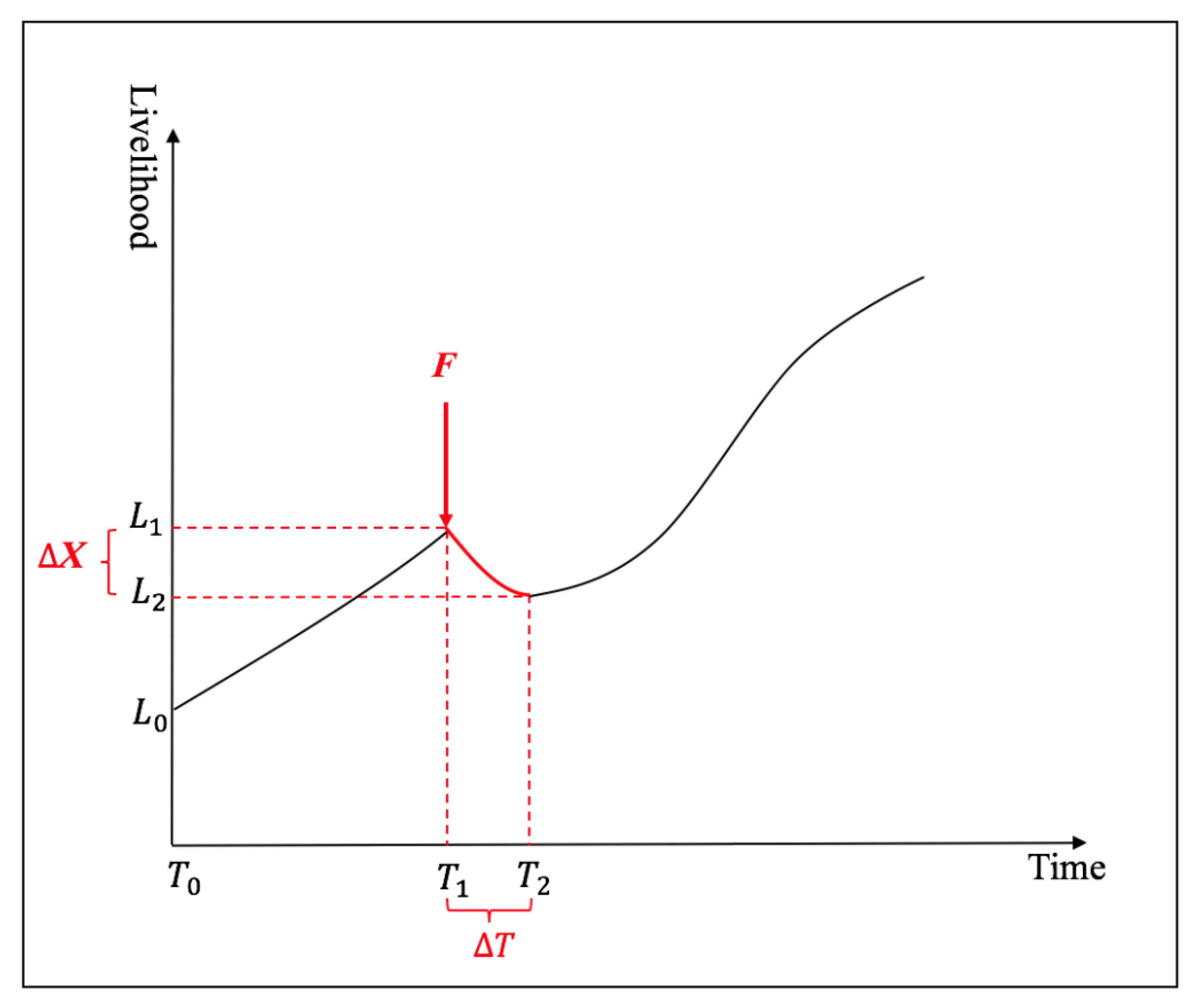
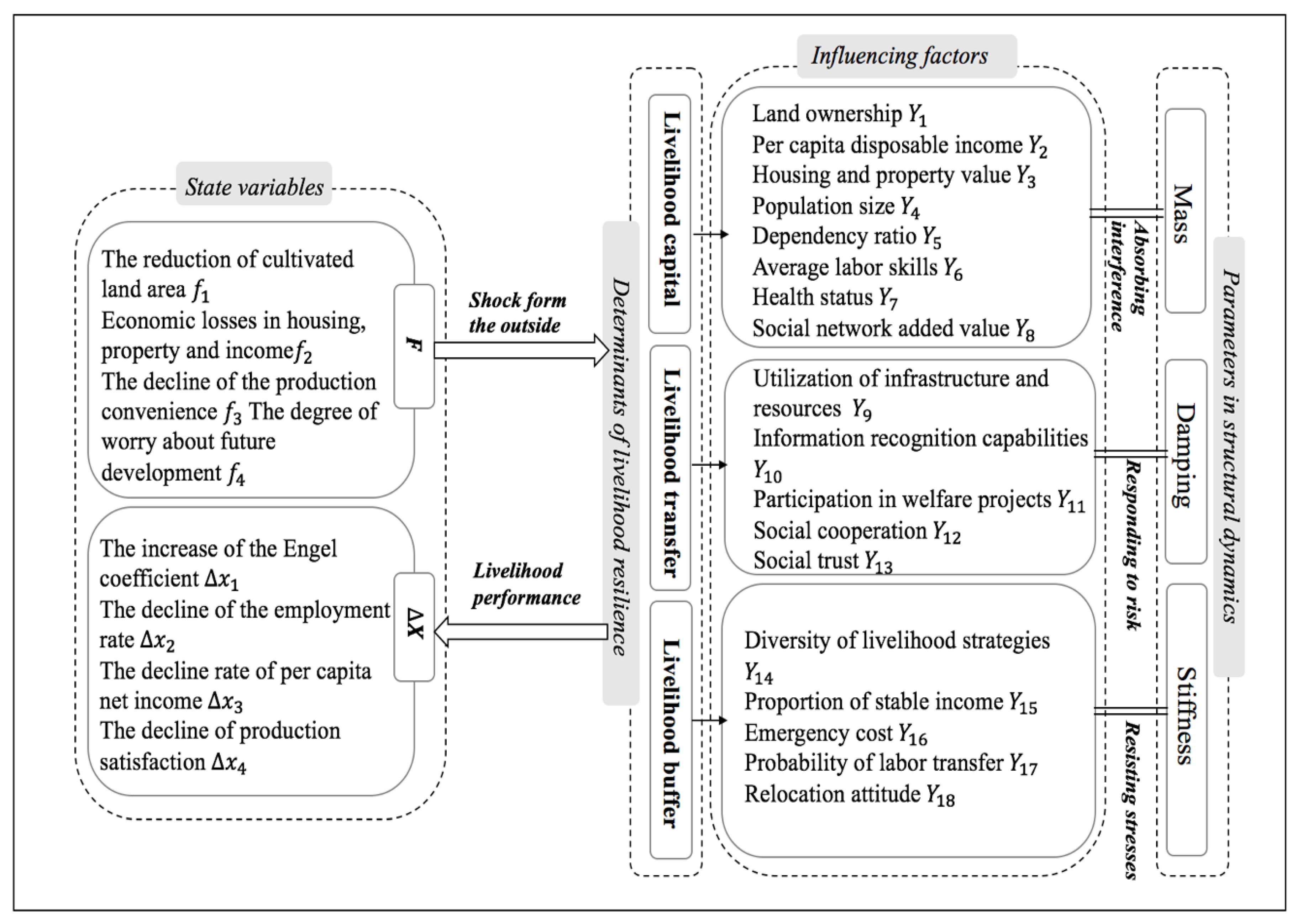
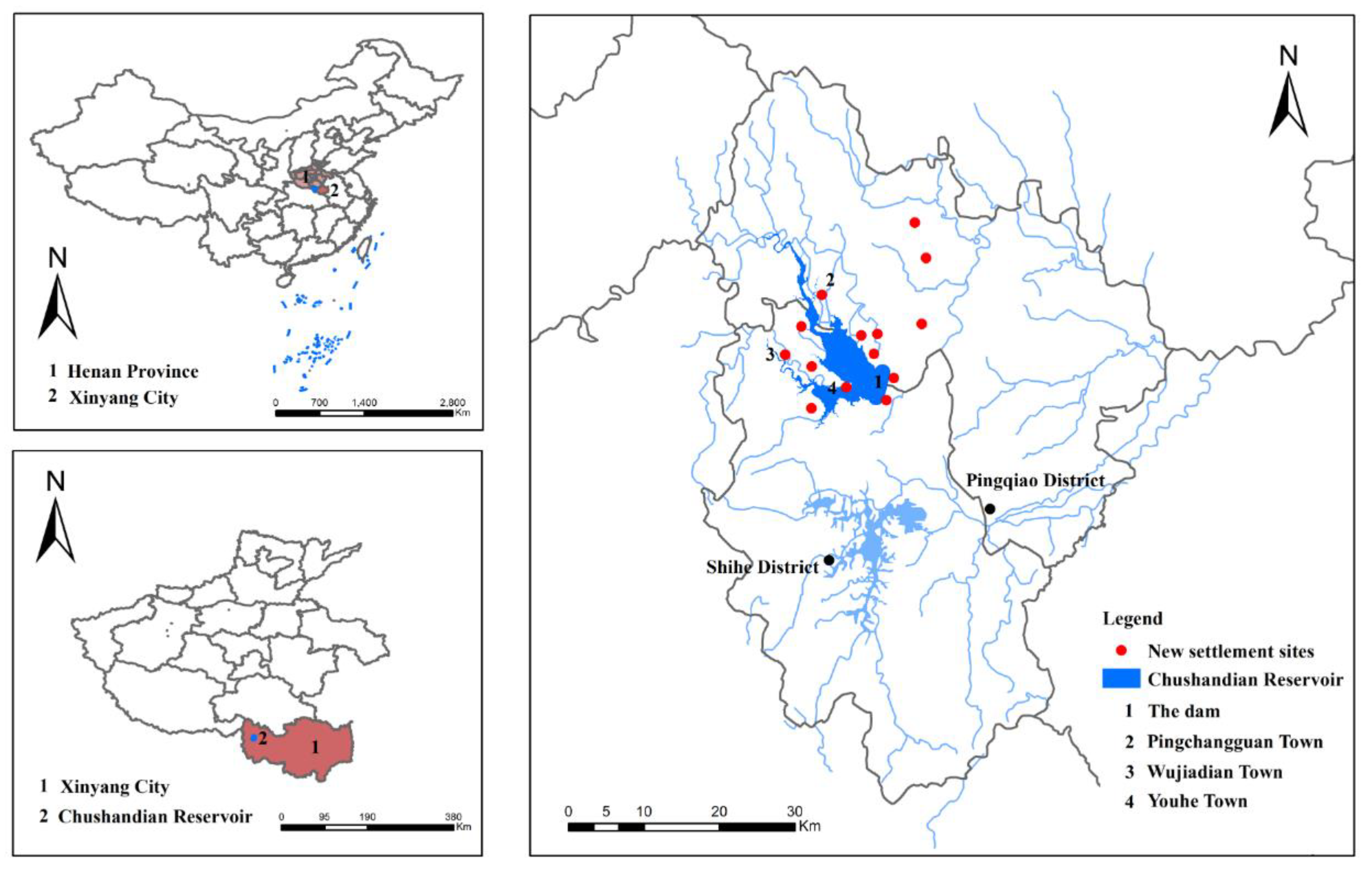
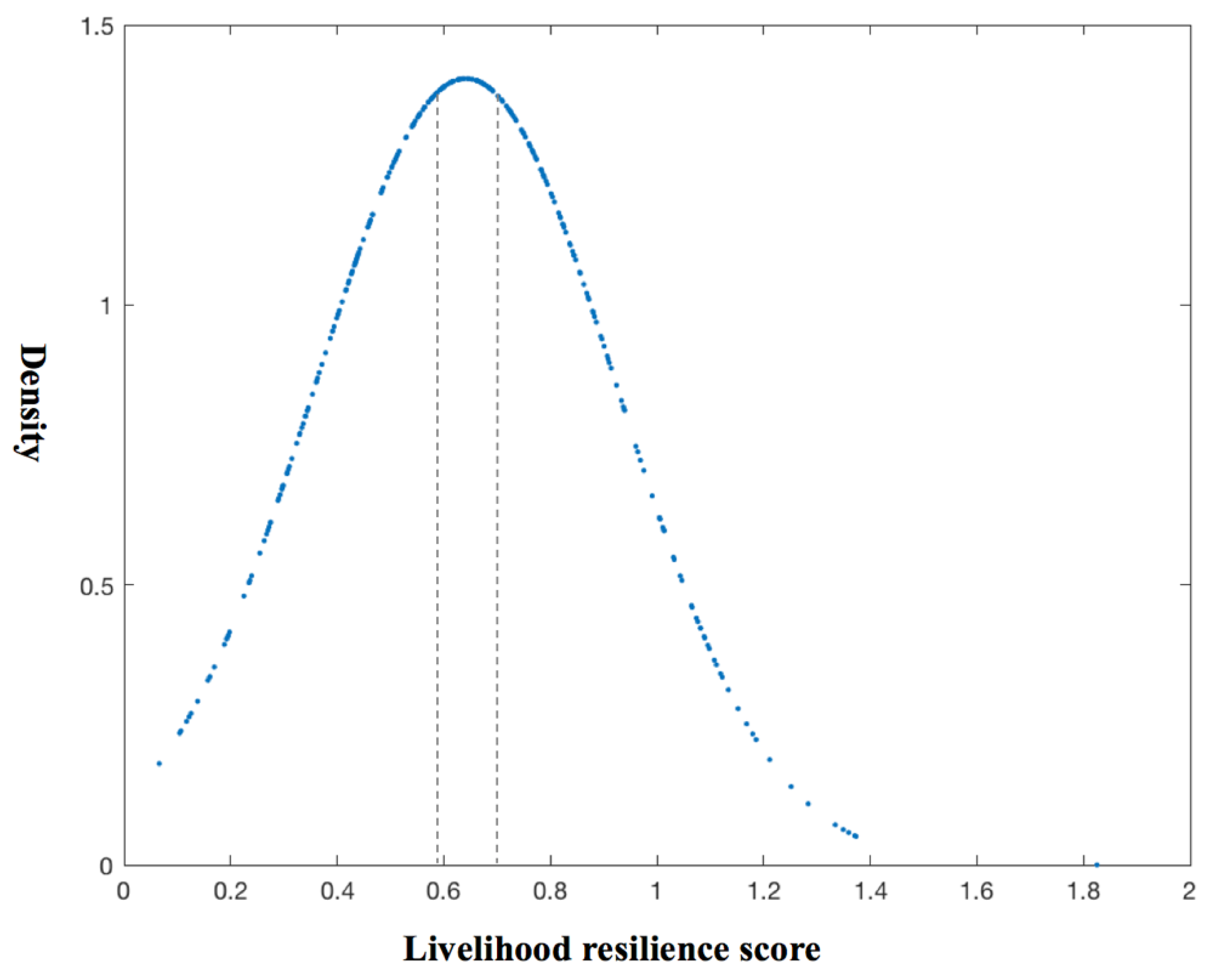

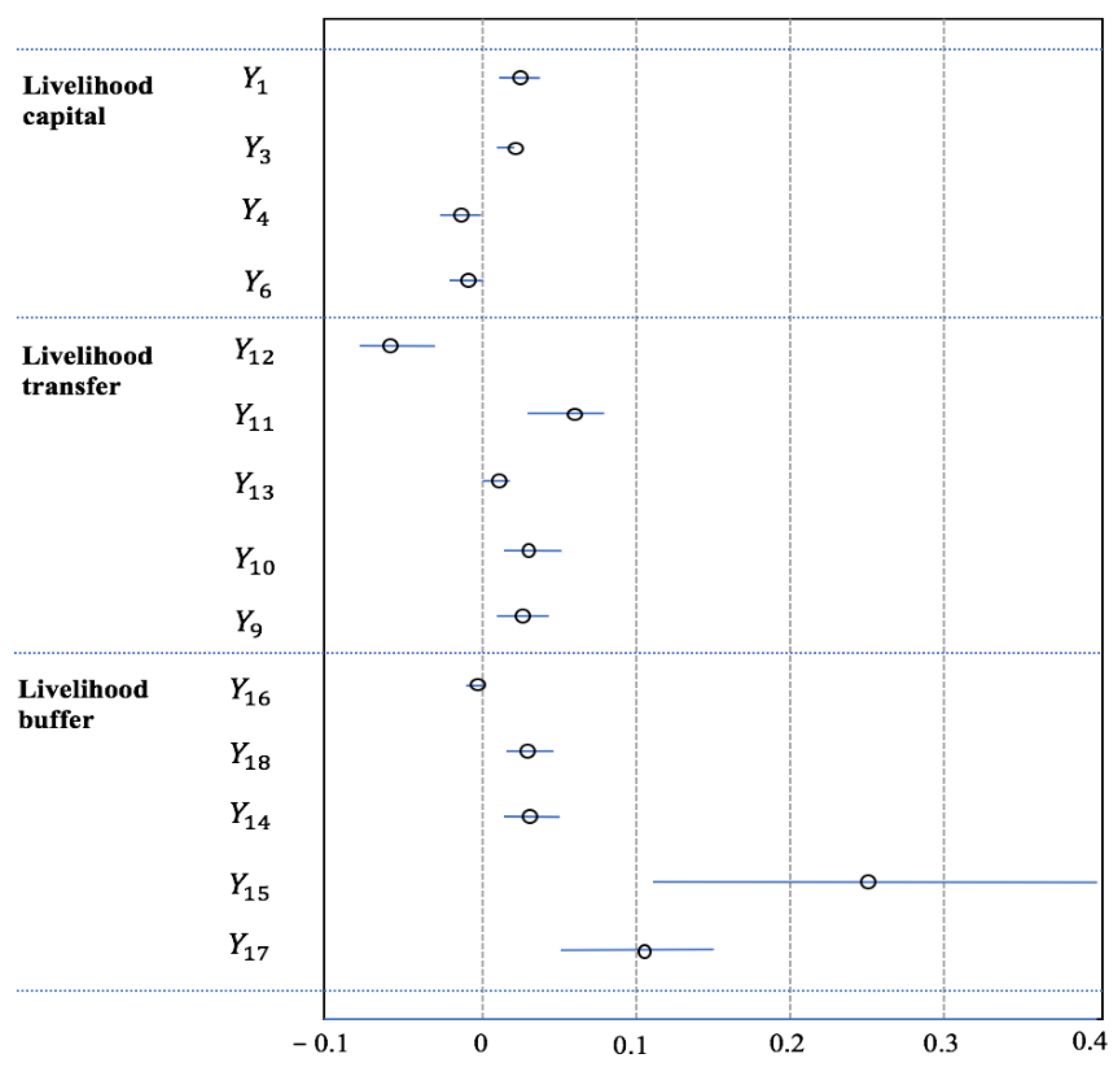
| Determinants | Indicator | Description | Polarity |
|---|---|---|---|
| Livelihood capital | Land ownership | Family’s cultivated land area | + |
| Per capita disposable income | Family’s disposable income per person | + | |
| Housing and property value | Value of fixed capital such as house and family property | + | |
| Population size | Number of people in the family | + | |
| Dependency ratio | Ratio of non-working-age members to working-age members | + | |
| Average labor skills | Average working years of the workforce | - | |
| Health status | Number of people with major illnesses or disabilities in the family | + | |
| Social network added value | Increased revenue due to social networks being able to use equipment, materials, personnel relations, etc. | - | |
| Livelihood transfer | Utilization of infrastructure and resources | Degree of utilization of the family’s production on the local infrastructure and resources (five-valued, with higher values meaning greater utilization) | + |
| Information recognition capabilities | Family members’ understanding and processing of resettlement information (five values, with higher values meaning greater ability to receive information) | + | |
| Participation in welfare projects | Number of projects participated in by family members to improve social and economic welfare | - | |
| Social cooperation | Number of family members serving in the village collective | + | |
| Social trust | Number of households in the local community that can provide loan or labor assistance | + | |
| Livelihood buffer | Diversity of livelihood strategies | Number of types of production activities in the family before relocation | + |
| Proportion of stable income | Proportion of income not affected by resettlement, including fixed wage income, minimum living security, and subsidies. | + | |
| Emergency cost | Emergency funds the family needed to borrow from banks | - | |
| Probability of labor transfer | Proportion of labor that can change production modes after relocation | + | |
| Relocation attitude | Family members’ expectations of changing the status quo in life (five-valued, with higher values representing higher expectations) | + |
| Overall Composite Asset Index | Component Asset Indexes | Individual Indicators |
|---|---|---|
| Overall livelihood capital | Natural capital | Farmland, farm crops, livestock, soil erosion |
| Physical capital | Road conditions, irrigation facilities, services | |
| Human capital | Labor availability, education, health | |
| Social capital | Family neighbors, group political influence | |
| Financial capital | Salary remittances, belongings livestock, bank account |
| Capacity | Question |
|---|---|
| Absorptive capacity | Your household can bounce back from any challenge that life throws at it. |
| Financial capital | During times of hardship, your household can access the financial support you need. |
| Social capital | Your household can rely on the support of family and friends when you need help. |
| Political capital | Your household can rely on the support of politicians and government when you need help. |
| Anticipatory capacity | Your household is fully prepared for the resettlement that may occur in your area. |
| Early warning | Your household receives useful information warning you about future risks in advance. |
| Independent Variable | Unstandardized Coefficient | Standardized Coefficient | t | Significance | Collinear Analysis | Contribution to Livelihood Resilience | ||
|---|---|---|---|---|---|---|---|---|
| B | Standard Error | Beta | Tolerance | VIF | ||||
| Land ownership | 0.027 | 0.002 | 0.410 | 12.282 | 0.000 | 0.679 | 1.473 | 17.58% |
| Housing and property value | 0.002 | 0.000 | 0.294 | 7.914 | 0.000 | 0.548 | 1.825 | 12.61% |
| Emergency cost | −0.002 | 0.000 | −0.243 | −7.016 | 0.000 | 0.629 | 1.589 | −4.15% |
| Social cooperation | −0.059 | 0.013 | −0.190 | −4.672 | 0.000 | 0.457 | 2.190 | −3.84% |
| Participation in welfare projects | 0.057 | 0.012 | 0.156 | 4.808 | 0.000 | 0.713 | 1.402 | −8.16% |
| Relocation attitude | 0.030 | 0.008 | 0.143 | 3.891 | 0.000 | 0.559 | 1.789 | 6.72% |
| Diversity of livelihood strategies | 0.031 | 0.009 | 0.139 | 3.616 | 0.000 | 0.514 | 1.946 | 4.82% |
| Probability of labor transfer | 0.105 | 0.029 | 0.123 | 3.633 | 0.000 | 0.659 | 1.517 | 5.20% |
| Information recognition capabilities | 0.032 | 0.010 | 0.121 | 3.210 | 0.001 | 0.531 | 1.884 | 4.15% |
| Proportion of stable income | 0.255 | 0.072 | 0.116 | 3.547 | 0.000 | 0.707 | 1.414 | −10.43% |
| Social trust | 0.009 | 0.003 | 0.112 | 2.720 | 0.007 | 0.443 | 2.257 | 6.14% |
| Utilization of infrastructure and resources | 0.025 | 0.009 | 0.097 | 2.867 | 0.004 | 0.663 | 1.509 | 5.95% |
| Population size | −0.014 | 0.005 | −0.097 | −2.699 | 0.007 | 0.588 | 1.702 | 4.97% |
| Average labor skills | −0.011 | 0.004 | −0.089 | −2.906 | 0.004 | 0.797 | 1.255 | 5.28% |
| Constant | −0.064 | 0.064 | −0.999 | 0.319 | ||||
| R2 | 0.780 | |||||||
| F | 73.785 | |||||||
Publisher’s Note: MDPI stays neutral with regard to jurisdictional claims in published maps and institutional affiliations. |
© 2020 by the authors. Licensee MDPI, Basel, Switzerland. This article is an open access article distributed under the terms and conditions of the Creative Commons Attribution (CC BY) license (http://creativecommons.org/licenses/by/4.0/).
Share and Cite
Gong, Y.; Zhang, R.; Yao, K.; Liu, B.; Wang, F. A Livelihood Resilience Measurement Framework for Dam-Induced Displacement and Resettlement. Water 2020, 12, 3191. https://doi.org/10.3390/w12113191
Gong Y, Zhang R, Yao K, Liu B, Wang F. A Livelihood Resilience Measurement Framework for Dam-Induced Displacement and Resettlement. Water. 2020; 12(11):3191. https://doi.org/10.3390/w12113191
Chicago/Turabian StyleGong, Yichun, Ruilian Zhang, Kaiwen Yao, Bingwen Liu, and Feilong Wang. 2020. "A Livelihood Resilience Measurement Framework for Dam-Induced Displacement and Resettlement" Water 12, no. 11: 3191. https://doi.org/10.3390/w12113191
APA StyleGong, Y., Zhang, R., Yao, K., Liu, B., & Wang, F. (2020). A Livelihood Resilience Measurement Framework for Dam-Induced Displacement and Resettlement. Water, 12(11), 3191. https://doi.org/10.3390/w12113191





